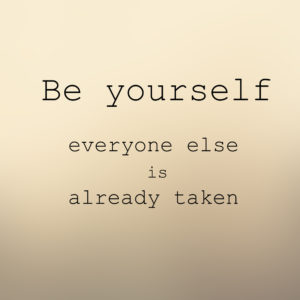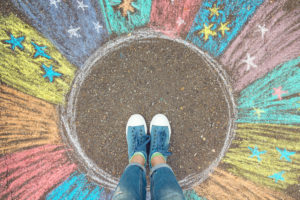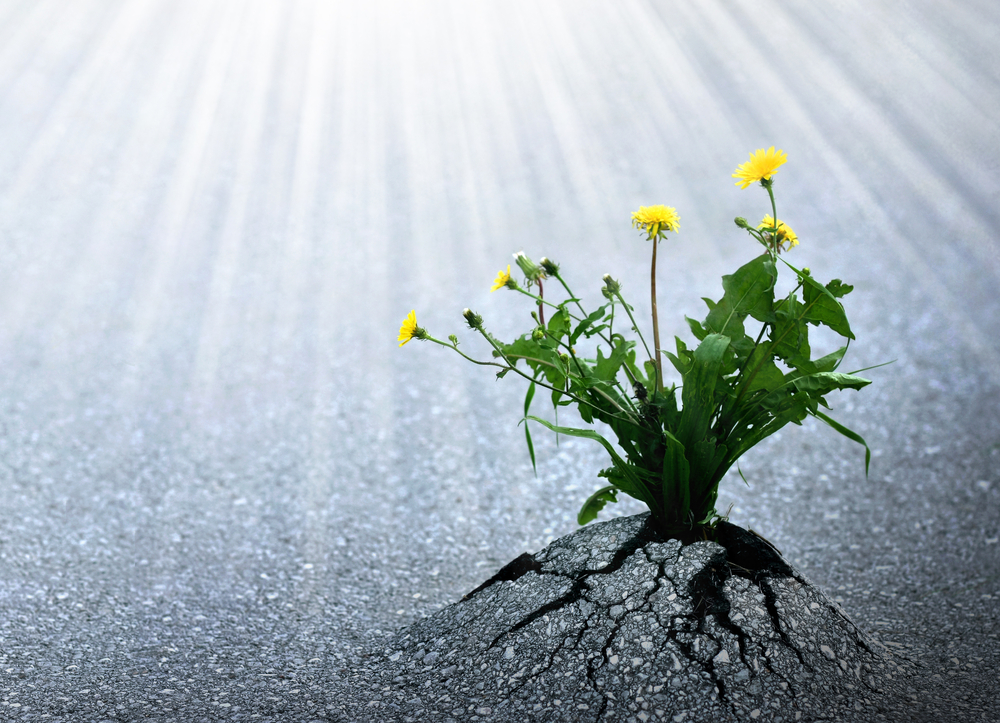There are many things that can distract and pull you out of your focused intent. While this can be annoying at times, other times, it can disrupt you to the point that you lose your creative flow and find it difficult to get it back.
However, there are ways to maximize your creativity so you can stay in the zone and reach your goals. The key is to find whichever method or combination of strategies works best for you, because no two people will be the same.
So whether you are writing your first book, planning a photo shoot, or visualizing your next painting you can stay on track and keep your creativity flowing with these tips.
 1) Engage in Daily Meditation to Listen to Your Creative Spirit
1) Engage in Daily Meditation to Listen to Your Creative Spirit
Being creative often invokes the image of working hard on whatever task you set out to do. You might strive to perform harder or to get more done than you previously did. But more often than not, doing more is the enemy of the creative endeavor.
You can’t force art in whatever niche you’re in. Your creative spirit needs room to breathe and to flourish. The way to achieve that isn’t by working more or working harder, but by soothing all of the inner voices that demand your attention and drain your focus.
Anyone with a goal knows the things that demand their time, lead to distractions and disrupt their mental flow. Your attention gets snagged by what’s going on online with work or entertainment.
You may have developed the habit where your brain is continually being fed information. It can become so used to being active that you begin to exist in a state of constant mental stimulation.
But for the sake of creativity, you have to gain focus. The best way to do that is to engage in daily meditation. When you practice this, you can regain your focus. You can quiet the inner chaos and gain perspective.
When you meditate, you’ll be able to boost your concentration. Using meditation, you’ll be able to calm your mind and stop the constant flow of internal noise. You’ll gain the ability to be able to clearly recognize issues and deal with them when your mind is focused.
With meditation, you’ll also be able to let go of the stressors that often bog down creativity. Meditation is best used by anyone in any type of business or situation who wants to free their creative spirit and regain focus.
There are many different types of meditation. One of these is mindful meditation. With this form, you train your mind to release the inner chatter and to gain a sense of calm. You learn to relax your body.
An example of this would involve sitting down with your hands loosely in your lap. You would breathe in slowly and concentrate on the breaths that you take in and then release.
Another type of meditation is transcendental meditation. With this type, you would practice not allowing yourself to have thoughts that disrupt your focus. You would also use a mantra during this type of meditation.
You can use guided or unguided meditation to help maximize your creativity. Start in the mornings or whenever your day begins. Sit quietly and focus on your breathing. Allow yourself to be present in the moment rather than letting your thoughts run unchecked.
This calming practice can help you unleash the power of your creative brain. You can use meditation whenever you need it. When you’ve lost focus, take a few minutes and practice meditation to get back on track.
If you feel stuck or like you’ve got a creative block, pause to practice whatever type of meditation you’ve chosen to use. There are several types of meditation that can boost creativity.
When you meditate, you’re opening your mind, and at the same time, you’re developing the skill to patiently focus and pay attention. When you meditate, you free your mind from both clutter and stress.
This creates a positive energy within your body that affects not just the work you do, but the creative effort you can give to whatever you’re doing. Practicing meditation also gives you the ability to be able to handle problems better.
Instead of wallowing in stress and frustration when things don’t go well, meditation can help you get back on track. It can do this because it helps give you a clearer decision-making process.
Meditation is a method that enhances the brain’s ability to solve issues. When you meditate, your brain isn’t constantly buzzing with the same thoughts. Because it’s clear and focused, your mind is able to welcome and create new avenues that not only help you solve any issues, but can show you new ideas or directions to take.
As you meditate, you’ll discover that you gain perspective for your life and ideas and you also gain the mental strength to do the things that are outside your comfort zone. Meditation is something that can disrupt the negative thought patterns to give you a can-do attitude.
You’ll be able to focus on the positive, even when the circumstances might not be great. You’ll be able to stay more relaxed and less fearful of the outcome of your creative efforts.
Meditation can also help soothe the negative moods that can often occur when you tap into the creative side of yourself. It’s common for people who are putting forth creative efforts to experience irritability, self-doubt, and to even hate whatever it is they’re creating.
People who create things go through a process of seeing the idea as a finished project within their mind. Then, what they create usually ends up not exactly matching the picture in their mind.
So they end up feeling like they’re not good enough. Meditation can help you give yourself the space to be creative by freeing you from the negative thoughts you might have about your work.
It helps you to learn to be kind to yourself and not to link what you do with who you are as a person. It eliminates the desire to achieve perfection every step of the way and instead be at peace with and proud of what you’ve accomplished.
 2) Rev Up Your Creative Routine with a Pre-Work Ritual
2) Rev Up Your Creative Routine with a Pre-Work Ritual
Many people have a pre-work ritual. These rituals can range from simple things to complicated steps. It depends on who’s doing the ritual. You’ll find this in all walks of life.
While not everyone has a pre-work ritual that they perform, a lot of people do. A musician might rub his “lucky” guitar pick between his fingers before going on stage. It helps him to connect with a memory of before he reached the point where he was able to grow an audience.
He remembers how much he wanted to be where he is. The pick connects him emotionally to that memory. An athlete might use only a certain type of clothing or dress in a particular order before an event.
Putting on the clothes in his mind is similar to putting on a mindset to help him become the athlete he wants to be. He gets into the zone by wearing what he does.
A writer may listen to inspiring music to get into the flow state or free write for a few minutes to work through her unconscious clutter that blocks her creativity.
It might seem that these are strange actions, but a creative person can have rituals they follow because it works for them to help them get into the creative zone.
Rituals disrupt the internal chatter to give a person a creative space within themselves. It’s like being let out to play. They’re now free to do whatever. The reason that this happens is because when you use rituals, it caused the brain to access a different level of consciousness.
You stop focusing on the things that hinder your creative work or ideas. Once this level of consciousness is accessed, it helps the person to be better at their creative endeavors.
There have been studies showing that a person with a creative brain just operates differently. A pre-work ritual is part of tapping into a different part of the brain. If whatever ritual they normally practice isn’t done before they get started, many creatives find themselves unable to perform or work.
The action that freed their creativity was disrupted and turns off the flow. It’s not uncommon for a person to feel paralyzed mentally. Pre-work rituals aren’t anything new. They’ve been around for a long time and the reason that rituals have worked for people throughout the centuries is because it causes the brain to associate the skills a person has with behavior.
It’s as if the behavior is the key that has the power to free the skills. The behavior is what’s found in the pre-work rituals. The rituals you have work because your mind has learned to associate the actions you do with an altered ability within the consciousness.
These rituals work as the gate. When you engage in them, it causes the mind to respond without you having to do anything else. This is something that happens automatically every time you carry out your ritual because the actions itself act as the gate opening or the triggers unleashing your talent.
These triggers are developed because of repetition. You have many things that you do based on repetition. You might jump out of bed in the mornings and shower, then brush your teeth because that’s the order you always do things in.
This is what happens to your creative self when it comes to your work. For example, in the mornings, you might open the curtains in your office, then get yourself a cup of coffee, and then sit down to start writing.
Your brain knows it’s time to write and that opens the flow. It’s the repetitious actions you do that matter because you have certain emotions that go along with the steps you take.
Seeing the start of a new day might cause you to feel happy or hopeful. You might hear the birds sing through the window. The sights and sounds trigger memories of prior creative work days.
Getting a cup of coffee might make you feel warm and remind you of all the other times you had coffee before you did something creative. The actions of opening the curtains and getting the coffee are triggers the mind has connected with a different consciousness.
The actions you do with these rituals signal to the brain that it’s time to write, or whatever action it is that you do after your ritual. You might have a ritual where you spend a few minutes playing a game online to clear your mind before you get to work.
The action of finishing the game is your trigger that opens up your creativity so that the work flows. Or you might have a special notebook you use to jot down ideas in any niche you’re in.
The ritual of seeing that notebook opens you up to creativity. What you want to do is to have a ritual that aids you in your creative efforts. You want to make sure that you’re not developing a pre-work routine that steals your time and makes you less productive.
For example, maybe you’re part of an online group in your niche and you always check it out in the mornings to bounce ideas off group members, to catch up on industry news or to look for solutions.
Interacting with like-minded individuals might help you feel motivated, so that’s why you do it. But you want to be careful that your ritual doesn’t suck you down into the rabbit hole of wasting time.
When you run short of time, that can put pressure on you. A lot of people struggle to perform with creativity when they feel pressured. Whatever your rituals are, make sure that they matter to you emotionally, and that they benefit the work you do.
 3) Shut Out Negative Energy and Usher in Can-Do Influences
3) Shut Out Negative Energy and Usher in Can-Do Influences
Naysayers are everywhere. They have plenty to say to you, but that doesn’t mean you have to listen to them. Being creative often brings out the negative people in your life. They want to give you reasons for why your ideas won’t work.
They’ll put down the ideas that you do share, always finding the worst case scenario to discuss with you. They’ll attack your abilities and tell you why you’re not the person who can make something happen.
These people are full of negative reactions or attitudes. They either don’t know how or just don’t encourage or lift you up. These negative people always seem to crop up at the worst time.
The minute that you have a dream or goal, there will be someone who puts you down for it. They might tell you that they’re only looking out for you – that they don’t want to see you embarrassed or hurt.
They might tell you they’re only trying to prevent you from failing. What they’re actually doing is holding you back and you need to recognize this. Realize that when someone talks about your ideas or something you’re working on and tells you it’s not good enough or belittles you, you need to take action.
You need to get away from that negative influence, stop the person’s words or learn to shake off what they’re saying. If this is something that’s been going on in your life, then you need to stop letting them know what you’re working on and anything else associated with your creativity.
Some people just aren’t going to be supportive no matter what you say or do. They won’t get it. They won’t understand what matters to you and may not even care to try to understand.
These people have made it clear that they’re not on your side by the words they say. Sometimes naysayers don’t perceive themselves as being negative toward you or your work.
They feel that they’re being helpful. The dangerous thing about naysayers is that by dumping their pessimism and doubt onto your efforts, they can cause you to develop doubts of your own.
This can be fatal to a creative endeavor. Self-doubt keeps you stuck at the beginning, afraid to take the next step. You’ll start to question if you can do this – if your work really is any good.
You might start to see only the negative side of things, just like the naysayer pointed out. When this happens, you might find that your motivation or creative well starts to dry up because it’s so full of negativity.
You can’t see why you can do something, only what you can’t do. People who are naysayers are often subtly negative. They might tell you that what you’re doing is too hard or that someone else has already done it better.
Sometimes they do this on purpose if they’re that kind of person. But other times, it’s a learned behavior they have. They keep acting this way because not many people will call a naysayer out on how they talk to people.
They might say something about your creative effort like “That looks pretty good for your skill level,” so then you start to question, “What about my skill level?” over that subtle dig.
Or they might say something like, “That’s not as bad as I thought it would be.” Then you wonder what it is about your work that made them think it would be bad. What’s happening is that person’s comments are feeding your insecurities.
The naysayer uses words or actions – whether intentional or not – to encourage failure. If you pay attention and let their words take root, it will cause problems. This is why you need to only allow positive people in your circle.
Positive people are like the sunshine where naysayers are the storm. Positive people shed light on the good. Their words are helpful and kind. These are the kind of people who influence you to keep going even during the times when things aren’t working out the way you’d hoped.
They make you feel fired up, like you can do this, like you can achieve your dreams or goals no matter what. They inspire you to create and to do things rather than stall you. These are the people who are important for your life and you need to have plenty of them in your inner circle.
You can find can-do influences for your life by surrounding yourself with people you already know who are positive and lift you up. Sometimes this might be friends. Maybe you have friends who believe in you.
They might not know anything about your niche or the kind of work you do. But because they give you the power of positivity, it supports what you do. Your can-do influences might be family.
They root for you and are there for you to talk to about your work. They’ll help you with encouraging direction, advice or be a shoulder whenever you need someone to listen.
Build a network of creative people that you can interact with.
Besides friends and family, you can look for groups online or in person that are dedicated to your type of creative endeavor. Meet up groups, business associations or organizations are good places to look for your beneficial influences.
Having this group of people can also help give you the support you need to keep going. Plus, you’ll have someone to bounce ideas off of or to seek advice from when you do encounter a problem or have to deal with a naysayer.
Be careful that you don’t become your own naysayer because this can be easy to do, too. Don’t give power to this inner critic. If you allow yourself to harbor negative thoughts, this can alter your mood as well as your behavior and cause you to want to give up.
 4) Say Yes to Opportunities
4) Say Yes to Opportunities
A few years ago, there was a popular book that became a bestseller. It was written by an introvert who had produced some of the hottest shows on television. This person hated being in public and would never say yes to things.
A lot of people are like that producer. More people than not give an automatic no when it comes to changing or doing something in their life. Even if they don’t say it out loud, they think it.
Sometimes this has to do with personality. People who are introverts often have a harder time saying yes to things because they find comfort in familiar settings or situations.
Saying yes pulls them out of that. A yes might cause them to feel anxiety or it might make them so afraid that they simply can’t imagine saying yes to whatever opportunity arises.
For those who aren’t introverts, people will sometimes say no because they don’t feel ready to give a yes answer to opportunities. That might be you. You may have developed a habit of automatically refusing to say yes because you don’t feel qualified.
You feel like you’re still trying to find your way and saying yes frightens you. This can happen if you’re someone who deals with imposter syndrome, or if you lack the same background or advantages as someone else in your line of work.
You might have practiced the comparison game and feel inept. You might say no if you’re fearful of the challenge that’s presented. Maybe another marketer wants you to join them in a bundle release and you don’t feel up to par – or you’re afraid of making a mistake or of being overshadowed.
You might be at a point where you don’t feel comfortable spreading your creative wings, especially when working with someone else. This really can be a bad thing because the problem is that if you don’t say yes, you stand to shortchange yourself and lose a lot more than you think.
Not saying yes can hinder your creativity, limit future opportunities and make you miss out on the very things that can change your life or help fulfill your dreams. Instead of looking at what scares you or what you might have to do by saying yes, decide that you’re going to go for it.
You have to leave the comfort zone behind and say yes as often as possible. You’ll reap a lot of benefits if you do this. You’ll grow as a person and maximize your creative self, too.
When you say yes, you open the door of your life so that new experiences and situations can enter. You never know when a yes today impacts your life for the future in a great way.
Some yes opportunities are already in your life and you just might not recognize them.
For example, you might be someone who has a business selling planner pages. Though you enjoy design, you’re afraid to say yes to the desire to create them yourself.
So you outsource. Instead, say yes to your own opportunity – to your own ideas. If someone you know and trust in your niche wants to collaborate with a product, but you’ve always felt awed because you see this person has reached an income level you’ve only dreamed about so far, don’t let that make you hesitate.
Just say yes and run with the chance to make that connection and boost your own business. Someone might invite you to be a speaker or to teach a class about your creative work.
Say yes even if the thought of standing in front of a group makes you feel shaky. Say yes to your ideas. For example, you might have an idea to launch a business or to branch out your business.
Say yes to that.
Saying yes can be in any area of your life. You might think about moving and going to a city where you’ll start over. Instead of mulling over all the cons of the idea, just say yes to the unknown and to the unexpected and go.
It could be that the move unlocks the creativity that was stifled where you once lived. A fresh start can give a fresh perspective. Saying yes as often as possible can be done for a specific period of time.
For example, you can choose to practice saying yes for a few months or for a whole year. What you’ll discover is that during this time, you’ll stretch your creative muscles, gain more confidence and open yourself up to even more opportunities.
You’ll find that you can do things you never thought you’d be able to do. But you do need to be cautious even while saying yes. Just because you determine that you’re going to practice this doesn’t mean that you should say yes to every single thing that comes along.
Some of the things may be bad for you or your career while presenting themselves as opportunities. You need the wisdom to be able to tell the difference. For example, there may be a dangerous situation and it wouldn’t be wise to say yes to that.
Someone might not be trustworthy and it’s okay to say no to working with or spending time with someone who could harm your creativity, your career or your personal safety.
In the end, what happens when you say yes is that you’ll go on a journey of discovering about yourself, and your work.
You’ll learn how the things you thought were impossible for you really weren’t. You’ll gain far more than you think you will by making this life change.
 5) Create a Swipe File of Things That Inspire or Impress You
5) Create a Swipe File of Things That Inspire or Impress You
A swipe file is a collection of things that you capture that either inspire you, impress you or give you ideas. Many people use a swipe file. You can use one for things like decorating your home.
For example, if you found a floor tile pattern you loved, you might swipe that to refer back to later when you’re ready to change your flooring. You can use swipe files to remember clothing styles or patterns that you want to emulate to build your own wardrobe ideas.
Business owners, marketers, photographers, writers, freelancers all use swipe files and look back through them when they need something to jolt them out of a creativity block. A swipe file can be a collection based on whatever you want.
It can also be used to help you study a particular niche. For example, if you’re an ad writer and you come across ads that jump out at you, you might save those for your swipe file.
Later, you can study them to figure out what elements about those ads were so compelling. You can use this knowledge to improve your own ad writing. This doesn’t mean stealing someone else’s work and using it.
It only means you look at stuff that you find appealing, inspirational, beautiful or whatever and you want to remember it. Even if you’re not an ad writer but you use ads in your own business such as advertising on Facebook or Instagram you can create a swipe file of those.
When you see an ad that you like, add it to your file. You can use a swipe file to create a study on what’s going on in your niche as far as what’s expected in any given area or topic.
For example, you might swipe titles that you like or title placement ideas. You might swipe colors that are used on a website or on a page that you see and think the two colors mesh well together.
You might find that you like a certain style and want to remember that. A swipe file is great at helping you to understand what’s working in any particular market. You’ll be able to study formatting techniques as well as how the information you’ve saved answers customers’ needs or grabs attention.
You’ll be able to find the unique selling point or a call to action that looks good. You can use a swipe file to help you brainstorm ideas when you’re coming up dry. You can use the file to help inspire you to create whatever content you need to produce.
A swipe file of the things you’ve saved can be used to help you create blog posts. Not copying the content, but studying the topic to see what’s relevant and if it’s something that you can talk about as well – but from a different angle.
You could save blog posts and study how they were set up and look at how the site used headlines or how the images were used. If you’re someone who sends out business emails or has an email list, your swipe files can help you understand what type of email works with customers.
You can study them to understand how to appeal to your target audience. You’ll be able to see if the emails are chatty and friendly or more professional. You’ll also be able to see how the emails handle sales or launch events.
A great idea for a sales or event launch email swipe file is to save the emails that you get from other businesses that are having a sale. You’ll be able to see what they say and how they handle the subject.
Some businesses send out funny sales emails, some have a lot of detail, while others are streamlined and stick to the sales information only. Headlines or subject lines are pretty popular to save in a swipe file.
For example, a headline that says “5 Ways to Find Love in the New Year” might inspire you to write a headline that says, “3 Ways to Focus on Self-Love in the New Year.” If you find fonts that you really like, you can add that to your swipe file, too.
When you’re ready to create something and are looking for a font, you can search to find out where that font was purchased and find it for yourself. Or, you can use the fonts for inspiration on creating your own new font.
Swipe files can help you see how to create better website pages. You might come across a website that has a beautiful, compelling design and content that you love. You’ll be able to draw inspiration from those pages later when you’re ready to set up your own website.
Your swipe file can be digital or tangible. If you choose to make the file digital, then you could save your content in something like Dropbox. Other people save their swipe file by creating boards on Pinterest.
Others store their swipe files on their computer in a folder. If you prefer to have tangible swipe files, you can print the content out and store it in folders. Or, you can create boards that feature the items that inspire you from the file.
For example, you can print out colors or fonts and pin those up by your desk to refer to.
You might come across quotes or images that you love. Add those to your swipe file for when you need motivation or a pick me up on any given topic.
A swipe file can quickly become a disorganized jungle if you’re not careful. When you add to it, make sure you put things in the correct space. For example, you might have a swipe file on fonts.
This file should have subfolders for where those fonts inspired you to use them such as in a blog post, on an image etc. If you come across a website page that you like, in your swipe file, the subfolder should be labeled as website pages. Each topic needs its own subfolder.
You might have things you’ve swiped that inspire you for when you feel like giving up. Create a subfolder labeled “Don’t Quit” or something like that and fill that with the stuff that helps you keep going when things are tough.
 6) Stop Conforming to Other People’s Idea of Creativity
6) Stop Conforming to Other People’s Idea of Creativity
When you conform to something, it means that, regardless of what you think or believe, you’re going to let go of that to instead pattern your thoughts, beliefs and then actions according to what someone else says is right or normal.
The problem is that when you conform, you give up your creativity, maybe the desire or drive to create outside the box to instead do what’s conventional. Fitting in is the behavior that everyone seems to follow so it feels “normal.”
Being unconventional feels abnormal and maybe even a little frightening. You might fail to realize that it’s the unconventional ones who end up having breakout success. These are the people who don’t care about following anyone’s footsteps – they’ll make their own way. Find their own path.
They don’t care that society says a person must go from A to B to C in order to succeed creatively. They’ll just start wherever they want and go for it. If you’ve been conforming, it’s because you have that ingrained in you.
Conforming starts early in life. From childhood, you’re taught to fit in. To be accepted. To behave in ways that others agree with. If you don’t, not fitting in can lead to being left out or ostracized, something most people find painful, so they avoid it.
But even more painful than that is conforming to other people, which also means you lose your individuality. You become one of the crowd. A dime a dozen. You learn to play it safe and to seek approval from others.
This causes you to second guess your creativity. You might downplay your ideas. Set smaller goals, Dream less big. The answer is to just stop worrying about conforming. Who cares if someone else says the idea of your creativity is wrong?
Who cares if they wouldn’t do it that way? Just because they have an opinion doesn’t make it the truth. The truth is within you. Your truth is what you create. So what if others don’t “get it” or feel like you’re on the wrong path?
You have to follow the journey that’s best for your life. You get to think up the plan, then work it. If you try to create by conforming, you lose your inspiration. That’s because it’s not you and you know that.
Conforming means your work will be second best and you’ll end up miserable. Uninspired. Wanting to give up. Conforming can equal failure when you follow others.
You were never meant to live out your creativity by following a set of rules or opinions.
Your creativity was always meant to be free. Don’t pretend that you’re someone else. You might not think that’s what you’re doing, but it is when you conform to someone else’s ideas for your creativity.
You grow creatively when you don’t conform. When you live unremarkably with your actions or life, then you create unremarkably. Nothing will stand out. No one, not even you will take note.
Creativity has to be nurtured and protected from being forced into a box that doesn’t fit the idea. When you stick to your ideas for what’s creative, you share more authentically because the work is authentic.
Not only that, but you’ll live your life choosing what matters to you with what you create rather than what matters to someone else. Choose not to worry about being different – about choosing your own creative path.
You might not see the safety net, but leap first and the net will appear. You will find your way and what’s right for you. Sticking to your authentic creativity is power. You gain confidence.
People notice. You may gain a following or find your tribe. You won’t have to try to find a place to fit in. The world will conform to you because you will have chosen what matters to you and because of that, you remove the danger of allowing what others think to rule over you or lead you on a journey you didn’t choose.
If you don’t want to do something that doesn’t fit your creativity, then don’t. Not a lot of people have the courage to stand strong under the influence of others – especially if those people are more experienced or experts in their field.
Keep in mind that just because they have an opinion, just because they made their way in the world, that doesn’t mean it’s what was intended for you. You have to determine what you want.
Set your goals, and bring your ideas to life. If there’s something or someone that’s getting in the way of your creativity, then it needs to be tuned out or it needs to go.
You have to be the leader for your creativity.
If you don’t, then you’re not in control. So when it comes to your creativity, whenever you feel the need to take a certain step, take a pause. Consider whether that thought is from you or if it’s because it’s what someone else or society expects of you.
Everyone – from financially successful people, to innovators to the people who shake the world, had a moment when they decided that conformity wasn’t for them. You can maximize your creativity when you do what you choose to do – when you stop giving in to what someone else says is right.
Choose to implement your creativity in every area of your life, whether it’s personal or work. Make the life that you want. It’s the only way that you’re going to be truly happy and excited about what you do.
 7) Spend Time Being Observant and Then Freestyling
7) Spend Time Being Observant and Then Freestyling
If you’re like most people, you’re probably busy. You’re always doing something to gather various kinds of information, then deciding how to use that information strategically to help with your creativity.
That’s not a bad thing – taking what you learn and then using it for your good. But sometimes, not deliberately seeking to find and use information like you always have can be even more beneficial.
Sometimes it’s good for you to spend time watching what’s going on around you. By taking the time to truly look, you become an observer. You’ll see situations and people. You’ll see events.
You’ll notice the speech and behavior and attitudes of others. The practice of observing can help you see things you may have missed in the past. It sharpens your internal vision.
This habit opens up your mind to new perspectives on things you have seen dozens of times already. You may even wonder how you missed that the first time you saw it. Take some time to read and to learn.
Gather new information and new insights. Doing this can help you to become better at observing, which improves your thinking skills. It strengthens the ability to analyze things.
You’ll be able to use this skill later when making decisions. During the time that you’re spending just watching or reading and noticing the world around you, don’t have a goal for the information that you’re gathering.
What you want to focus on is making sure that you take in all the information using all of your senses. Pay attention to the things that you see. Notice what you hear – what you can smell and what you touch.
Allow the sensations to become part of your observation. When you become an observer, it also helps you become objective. You’ll be able to notice certain patterns of behavior or certain end results in everything you pay attention to.
This skill can then help you objectively notice things about yourself. You might notice a certain style of behavior just by observing other people. You might pick up on styles in other forms of creativity and it enriches your own creative development.
By observing, you gain without giving anything out. What this does is it fills the creative well. It can spark ideas or stir motivation. The things that you create are part of who you are.
These creations are made up of how you think, what you believe, etc. The environment that you came from as well as the one that you’re in now are part of your creativity. By absorbing the world around you, you deepen your well.
Once you’ve finished observing, then spend some time freestyling. If you’re not familiar with that term, it means you just let the flow take over. Whatever you think or feel, however your heart guides you, you simply let those ideas come to life.
For example, if you’re writing something, you wouldn’t worry about theme or sentence structure or grammar or perfection. You wouldn’t worry about the end result of the words.
You would just write. You wouldn’t worry if the sentences were grammatically correct. You wouldn’t pause to edit your thoughts. You’d just let the words pour out of you and allow them to take on a life of their own.
Freestyling means without intention. You have no predetermined goal in mind. No objective. You just sit and create. This can lead to great works of art and accomplishments.
That’s because freestyling allows the mind to overcome objections. These objections can be found in any types of creativity. For example, in writing, freestyling allows you to overcome the critical internal editor.
By just writing without intention or direct goal, you give in to the beauty of the words and their flow rather than what purpose the words are intended to serve. This frees you to let the process unfold.
Many creatives experience success by using freestyling. They’ve spent time observing and now they just let go. Most people, when they’re engaging in something creative, start to experience a lot of pressure.
There’s pressure to perform. You’ll see this in areas like music or entertainment as well as the art world and even the business world. When you have something you must produce, it often causes the creativity to freeze up.
You may be like that. You might struggle to produce under pressure. When you need to create, you find that you’re drawing a blank and all your thoughts are blocked on what direction to take.
You have no idea what to say, or how to start, much less finish a project. This is why it’s important to spend time just observing and noticing the world around you. Once you develop this habit, you’ll have a well that you can draw from.
When you freestyle, not only does it take away the immediate and intense pressure, but you’ll also notice that you don’t feel as stressed. You’ll feel free to just create whatever you want.
 8) Try New Things Or Try Old Things in a New Way
8) Try New Things Or Try Old Things in a New Way
If you always do the same things you’ve always done, you’re missing out on a lot. The experiences that you miss out on could be the very thing that you need to do to maximize your creativity.
By trying new things, you open yourself up to ideas that may be the exact thing you need to jumpstart a project – or that takes your life in a better direction. Trying things you’ve never experienced expands your horizons.
Not only does it give you new ideas to learn from, but it also opens you up to more knowledge and possibly new skills. You may even meet people when you’re trying out new things that can help you to accomplish more or that you learn from.
Not only will you expand your knowledge and learn more about life, but you could also expand your inner perspective and learn things about yourself that you never realized.
Opening yourself to new experiences can prevent you from falling into a rut creatively.
You’ll discover that just because you’ve always done something one way, doesn’t mean it’s the only way and you might like your new experiences even more. Trying new things shakes up the routine and prevents you from doing things just because that’s always the way it’s been done in the past.
Not only will you grow outwardly, but inwardly as well. You’ll learn that you have more things to be excited about – more to try – and it gives you a deeper well to pull from. Others will find you more fascinating because of the deeper level of experience or a different view that you’ll gain.
When you try new things, you’ll learn that what you always avoided, you might like after all. You’ll also find that you might have been missing out on opportunities or experiences that give you a better perspective on issues.
When you’re open to new things that you’ve never tried, you’ll find that you have more confidence based on the self-growth. You’ll be more likely to take chances in the future that can help you in whatever creative idea you have once you start trying new things.
Sometimes trying something new can mean changing your process. You might be someone that’s always visited other cities or countries on a plane. Try heading to these places using a boat to travel on.
This allows you to see what more there is to the same experience. Traveling by boat might open you up to the beauty of the ocean, to the peacefulness or majestic waves of the water.
You’ll see nature’s art presented in a different way than your normal path. Maybe you’ve always traveled, but you stuck to things that were within your comfort zone. For example, maybe when you traveled, you made sure that you had good hotel accommodations.
Try something new, such as getting more involved in the local culture. Stay in a portable shelter like a yurt. Rent a cave house. Or stay in a treehouse. Stay in an ice hotel. Find a type of accommodations that’s different and maybe even the opposite of what you’d normally do.
If you plot out your destinations from beginning to end when you travel, don’t do that. Instead, take some time off, hop in your car or rent an RV and just see where the road takes you.
You’ll gain experiences that you wouldn’t normally get to be part of by sticking to a travel agenda. Choose an activity that you wouldn’t normally do. Take part in a group event like a zombie walk or work in a play.
Go backpacking across a country or choose to hike up a mountain you’ve never hiked before. Do what challenges you. Visit a ghost town. Ride the scariest roller coaster you can find or take a hot air balloon ride.
Learn how to scuba dive. Take a snorkeling adventure. Go bungee jumping. Get into a shark cage. Learn how to surf. The reason that you want to try new things like this is that every time you expand your experiences, and you grow as a person, your creativity also grows.
That’s because you bring those experiences to the table when you create. You don’t always have to leave your state when you try new things. You can try new cuisine when you dine out, even if it’s locally.
If you’ve never had Thai food, give it a try. Learn how to cook the way that other cultures do. Make a specific dish or two. Learn some of the customs from the place where the food originated from.
If you’re a writer, try to write in a completely new genre – maybe one that stretches your writing muscles. For example, if you write horror, write romance. If you write adult contemporary, write a children’s book or a young adult book.
If you write novels that are more serious, try your hand at writing humor. You can do the same with work related stuff, too. If you’ve always used a certain software, try something different.
If you’ve always relied on specific resources, try a new way. Learn something fun, such as archery or learn karate or self-defense. Learn a new language or how to play a musical instrument.
Learn computer programming. Take lessons to learn how to ride a horse. Learn how to ski. You want to try new things that expand your creativity and make you feel happy. You’ll be able to discover more to life. Plus, you’ll find that you’re able to put what you’ve learned to good use in your personal or professional life.
 9) Try Creating with a Partner
9) Try Creating with a Partner
You might be someone who’s used to creating by yourself. It could be because you’ve always done it that way, so you haven’t considered another option. Creating with a partner can give you many benefits.
When you work with someone else, it allows you to boost your productivity. You’ll be able to get more completed working fewer hours. Plus, you’ll notice that your stress levels will go down, too.
When you have a partner, you can gain a clearer vision and stay motivated, too. That’s because you’ll have someone to share goals with. You’ll see that having someone else working with you creatively gives you a different perspective because you’ll have someone to bounce ideas off of.
This person can help to flesh out an idea. You might have the bare bones and the excitement of whatever it is you want to do and you talk about it with a partner. That partner can then fill in the blanks and this can enable you to see things you might have otherwise missed.
You might have decided to go in one direction, but after finding a partner, you discover new doors in different directions. These could be options or opportunities that you would have missed out on if you weren’t working with someone else.
People who work with a partner gain an increase in skills because they learn from the other person and they’re able to take that knowledge and apply it. This leads to a greater understanding in whatever niche you’re in or whatever project you’re working on.
Creating with a partner allows you to take big tasks and turn them into smaller tasks that each person can work on. You can bring the best of your strengths to the table and the other person brings the best of theirs.
This can help with everything from the planning stage all the way to the development or implementation of whatever you’re doing. When there’s something that you’re struggling with, you’ll have someone there who can help you get around that obstacle – or, that other person can work with you to help figure out a new direction to take if one’s not working.
Creating can sometimes do a number on your self-esteem. You’ll start to doubt your abilities. That’s why you need a partner. If questions or doubts arise, you’ll have someone you can have a conversation with.
If you’re stuck in a creative area, you can get productivity flowing again when you have someone else telling you that you’re on the right track. Their assurance and support can silence the inner critic that’s doubting your abilities or vision.
When you make a move or create a product or have an idea, a partner’s feedback can be invaluable. Seeing the work through someone else’s eyes can often help you tackle issues in the beginning stage rather than after the fact.
This can save you a lot of time as well as money if you’re working on projects for profit.
A partner can also challenge you to do better – or give you an alternative to an opinion you have that you might have regarded as being the right thought or direction.
You’ll be able to refine or develop better creative habits or projects with a partner. For example, you might have a tendency to slack off in an area that you don’t feel sure about.
A partner can push you to learn more to be able to do better. Finding a partner doesn’t have to be a big deal. But there are some things you’ll want to consider when choosing a partner.
You want to make sure that you’re able to trust this person. If you’re not, then no amount of time or effort is going to break down the wall between the two of you. You’ll always be on guard.
The other person should be someone that you respect. You know or have seen their abilities or qualities in action and believe that the two of you would be a good fit working together.
Most importantly, you want the partner you work with to be honest. This person should be someone that will tell you the truth, even if that truth stings. The two of you should be able to have open conversations without egos getting in the way.
This person should have the ability to brainstorm with you and help you come up with or develop new ideas. If you’re working on a project, they should be able to give you constructive criticism on what you’re creating.
But this person should also be someone who can take constructive criticism as well. You can connect with a partner by networking. You can go to events or local meetups that are in the field you’re working in.
Or you can reach out to someone that you currently know whose creative achievements you already respect and ask them to work with you. Look in groups that are in your niche or your personal groups and put out a post that you’re looking for a partner.
Detail in the post what exactly you’re looking for and how you would hope the partner can help. Reach out on social media platforms where the kind of partner you’re looking for would hang out.
Network among the contacts that you already know. Ask your friends about their friends and arrange a meeting to discuss a partnership. This can help you get a feel for that person as to whether or not you’d be a good fit.
 10) Repurpose Your Ideas in New and Different Ways
10) Repurpose Your Ideas in New and Different Ways
If you’re like most people, you run out of time in the day before you run out of work or projects that you need or want to do. That can put a lot of pressure on you, especially when it comes to finding enough time.
No one said that all ideas had to be brand new in order to work well. Sometimes, there’s simply no need to reinvent the wheel. When you try to start from scratch with new ideas, that can take a lot more of your time and plenty of brainstorming – not to mention the pressure that can build because you feel like you must create in order to move forward.
Don’t spend the time or effort unnecessarily. If you’ve already done something that’s working for you, just make it work again. You can take the things that you’ve already created, and just repurpose them.
There’s no pressure when you use the ideas you’ve already come up with. There’s no starting over and wondering if the idea is going to work. When you’ve had an idea that’s already worked, already served a purpose, it’s okay to put it use again.
You just change how you’re going to use that idea. This can be especially helpful when you’re working with content that’s evergreen. The information you shared previously can still be in style or good to use currently.
You can take something from one format and just put it into a new kind of format. All you’re doing is giving it a new life. What this does is doubles or triples the value of the content because you’ve made it work more than once.
You can take content that you’ve written and change it up. For example, if you’re written a blog post, you can use the same topic and tweak it so that it has a new slant on the same subject, or even flip the slant.
For example, if you’ve written a blog post on using social media to increase profits, you could slant the same post toward how using social media can hurt profits if done the wrong way.
You could add in tips on how to get the most from having your business on social media without loss such as time, energy, money etc. You’ll save time by repurposing the same material and it’ll still be relevant.
You can take that same blog post that you’ve just repurposed and mine it for things like tweets or ideas for images that you can put on your Instagram account. You can go through your previous blog posts or social media posts and use the information that you already have to turn it into a presentation.
If you’re teaching a course or writing an article on the subject you’ve been talking about, then you’d already have the material. You put the information in a slide show like a PowerPoint presentation.
You can take one article and use the subheadings in that article to create several mini-articles to use elsewhere. Or you can take that article and break it down into several emails that you can send to your subscriber list.
You can take creative things you’ve already done and use them in pie charts to show data in whatever categories you’ve been working on. Old materials can be used to create tutorials.
For example, if you have a series of articles or blog posts or even social media posts where you’ve shared how to do something, you can put those together in a YouTube tutorial.
Or, you can put them together in an eBook that you can turn around and sell. If you find that social media has been a time suck for you, you can scroll back through your posts, select some and present them as a “throwback” or “best of” whatever month or year, then link that information to whatever you’re currently working on.
If you were working on creating graphics a year ago and now you’ve found something more to add or you’ve found a resource that’s faster or cheaper than what you listed previously, you can take that old information, and add a note saying, “This is what’s new” (on the same topic) paragraph.
Anything that you’ve created can be turned into a new media format. If it’s written, you can turn it into an audio. There are plenty of tutorials that can teach you how to take your articles or documents and turn them into an audio series or a podcast.
If you’ve already created a book, then you could turn that into a graphic. Or, you can take that book and turn it into an audiobook. Visual creative things are well received. You can take something that you’ve created and turn it into a video series.
Taking something old and giving it a new style gives you the potential to take that and reach an entirely new audience. For example, some people won’t touch a written book, but they’ll buy plenty of audiobooks.
The reason repurposing your old creations is helpful for you is because you can branch out into other areas using other elements and options. This takes away the stress of having to start from scratch.
It gives you the chance to try something new without also having to come up with a fresh idea. By reaching a bigger audience, you can expand your business, establish your brand, grow your authority and boost profits all at the same time.
Wrap-Up
Tapping into your creativity is one thing. Some people have been able to get the ball rolling with no problem. But when you lose steam or find your creativity lacking, you may want to try one or more of these ideas to maximize your ability to create and focus on producing quality products and content.

